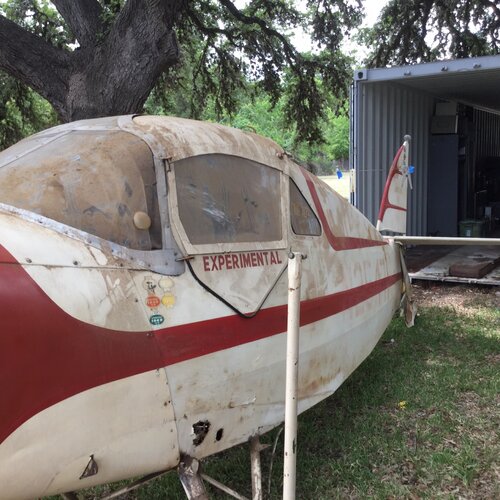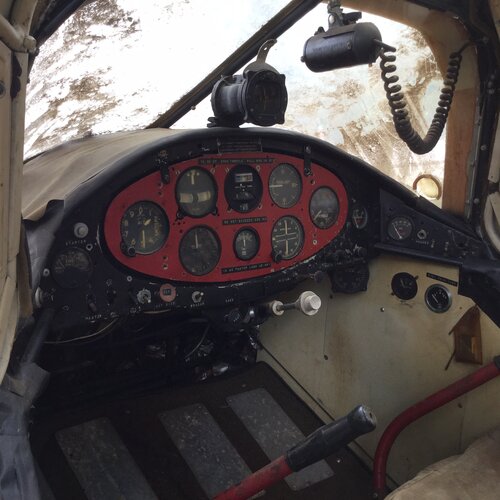- Joined
- 25 June 2009
- Messages
- 14,141
- Reaction score
- 4,333
Hi! the Stearman company existed long before the company was taken over by Boeing. And even when it became Boeing-Wichita, it continued to use its own model numbering system for a while. Here's a simplified version of the list:
C-1 / C-1X / C-3A (c/n 101) (N?4100)
C-2 / C-2A / C-2B / C-2H / C-2K / C-2MB? (c/n 102/132)*
C-3B Sport Commercial / C-3B Special / C-3C / C-3D / C-3F / C-3H / C-3K / C-3L / C-3MB (c/n 133/248)*
1 M-2 "Bull Stearman" / M-2 Speedmail / M-2 Special (c/n 1001/1007)(N?9051/9055,8199,8827)
2 LT-1 Light Transport (c/n 2001/2003)(NC8829,8832,8833)
3 CAB-1 Coach (c/n 3001, N?8808)
4 Model 4 Speedmail (41 built, c/n 4001/4041)*
C-4 / C-4A / C-4E?
Model 4-C Junior Speedmail
Model 4-CM/4-CM1 Senior Speedmail
Model 4-D/4-DX Junior Speedmail
Model 4-DM/4-DM1 Senior Speedmail
Model 4-E Junior Speedmail
Model 4-E Special
Model 4-EM/4-EM1 Senior Speedmail
Model 4-EX Senior Speedmail
Model 4-RM Special
5 C-3R Business Speedster (c/n 5001/5039)*
C-3P (c/n 5039)(NR/NC567Y)
6 Model 6 Cloudboy (10 built, a.k.a. Boeing Model 295):
c/n 6001 (X/NC786H) = Model 6-A / Model 6-F / Model 6-D / Model 6-L / Model 6-H, USAAC YBT-5
c/n 6002 (NC787H) = Model 6-A / Model 6-F? / Model 6-P / Model 6-L?
c/n 6003 (NC788H) = Model 6-A?/ Model 6-F / Model 6-P / Model 6-L
c/n 6004 (NC795H) = Model 6-A / Model 6-L
c/n 6005 (USAAC YPT-9)(31-460) = Model 6-A? / Model 6-F
c/n 6006 (USAAC YPT-9, YBT-3, YPT-9C)(31-461) = Model 6-A? / Model 6-F
c/n 6007 (USAAC YPT-9)(31-462) = Model 6-A? / Model 6-F
c/n 6008 (USAAC YPT-9, YPT-9A, YPT-9B) = Model 6-A? / Model 6-F
c/n 6009 (NC564Y) = Model 6-H / Model 6-A / Model 6-L
c/n 6010 (N?2143) = Model 6-C
Model 6-L1 (preliminary study for X70 prototype)
7 Model X70 Sportster (c/n 7001, X571Y) (USAAC evaluation as XPT-943)
Model 73 (c/n 73000)(NC571Y?) (became Navy XNS-1, no military registration)
Model 73B1 (US Navy NS-1) (c/n 73001/73061) (Navy #9677/9717 and #0191/0210
Model A73B1 (c/n 73072/73078) (Cuba, #43/49)
Model 73L3 and A73L3 (c/n 73062/73071) (Philippine Constabulary)
Model X75/X75L3 (c/n 75000) (USAAC XPT-945, procured as XPT-13) (NX/NC14407 > 36-2 > N53226)
Model 75(L1) (USAAC PT-13 Kaydet) (c/n 75002/75026) (A.C. #36-3/27)
Model A75 (USAAC PT-13A Kaydet) (c/n 75027/75098) (A.C. #37-71/114 and 37-232/259)
Model A75L3 civilian and export version: private (4), Brazil (20), Philippine O-1 (12), Venezuela (7)
(under ATC-743, post-war conversions of A75, B75 or E75 models became A75L3 too).
Model A75L5 export variant for China (20 built, + 2 probably built locally under license)
Model A75L300 any Model 75L/N/J planes modified according to Misssissippi Valley Air
Service, Clarksdale, Mississippi
Model B75(L1) (US Navy N2S-2) (125 examples originally from Army production)
Model E75(L1) (USAAF PT-13D Kaydet and US Navy N2S-5)
Model E75L300 probably similar to the A75L300 modification
Model 75N1 Kaydet (existed?)
Model A75N1 (USAAF PT-17/A/B Kaydet, US Navy N2S-1, N2S-4 and Philippine PT-13)
(under ATC-743, the designation was also given to all PT-17/-27/N2S-1/-3/-4 post-war conversions)
Model B75N1 (US Navy N2S-3 and post-war conversions)
Model D75N1 (RCAF PT-27 Kaydet, 300 built)
Model E75N1 apparently former E75(L1) planes modified with Continental engines
Model A75J1 (USAAF PT-18 Kaydet and post-war conversions)
Model A75B4 export variant for Venezuela (5 built)
Model IB75A designates any Model 75L/N/J planes modified according to Inland Aviation Co.
Model A76C3 version for Brazil (15 built)
Model B76C3 version for Brazil (15 built)
Model 76D1 version for Argentina (6 built) and the Philippines as BT-1 (3 built)
Model S76D1 seaplane version of above, also for Argentina and the Philippines (19 total)
Model 76D3 armed advanced trainer for Philippine Constabulary as BT-1 (24 built) and for Cuba (24 built)
Model A76B4 version for Venezuela (5 built)
8 Model (X)80 Sportster (c/n 8001, NC11720)
Model 81 Sportster (c/n 8101, NC570Y)
Model 82 Sportster (undocumented version, probably cancelled)
Model X85 (U.S. Navy XOSS-1, c/n 85000, USN #1052)
9 Model X90 (PT contender, rejected) (c/n 90000, NX21924)
Model X91 (USAAF XBT-17, c/n 91000, USAAF 42-8726)
10 Model X100 (USAAC XA-21, c/n 100000, A.C. #40-191)
11 ??
12 Model X120 Crewmaker (USAAF XAT-15, c/n X120000/X120001, A.F. #41-23162/23163)
Model 120 (USAAF AT-15-MC production version by McDonnell; cancelled)
? Waco CG-4A-CE (Cessna subcontract)*
? Boeing B-29 Superfortress*
? Boeing B-47 Stratojet*
20 Model 200 Scout (USAF XL-15, c/n 200001 and 200002, A.F. # 46-520/521)
Model 200 Scout (USAF YL-15-BW, c/n 200003/200012, A.F. # 47-423/432)
? Boeing B-52 Stratofortress*
NOTES:
- Figures in red are NOT model numbers, but numerals that indicate order of project. They make up the first two figures of the constructor's production numbers.
- Asterisk (*) indicates registration numbers too numerous to mention here.
C-1 / C-1X / C-3A (c/n 101) (N?4100)
C-2 / C-2A / C-2B / C-2H / C-2K / C-2MB? (c/n 102/132)*
C-3B Sport Commercial / C-3B Special / C-3C / C-3D / C-3F / C-3H / C-3K / C-3L / C-3MB (c/n 133/248)*
1 M-2 "Bull Stearman" / M-2 Speedmail / M-2 Special (c/n 1001/1007)(N?9051/9055,8199,8827)
2 LT-1 Light Transport (c/n 2001/2003)(NC8829,8832,8833)
3 CAB-1 Coach (c/n 3001, N?8808)
4 Model 4 Speedmail (41 built, c/n 4001/4041)*
C-4 / C-4A / C-4E?
Model 4-C Junior Speedmail
Model 4-CM/4-CM1 Senior Speedmail
Model 4-D/4-DX Junior Speedmail
Model 4-DM/4-DM1 Senior Speedmail
Model 4-E Junior Speedmail
Model 4-E Special
Model 4-EM/4-EM1 Senior Speedmail
Model 4-EX Senior Speedmail
Model 4-RM Special
5 C-3R Business Speedster (c/n 5001/5039)*
C-3P (c/n 5039)(NR/NC567Y)
6 Model 6 Cloudboy (10 built, a.k.a. Boeing Model 295):
c/n 6001 (X/NC786H) = Model 6-A / Model 6-F / Model 6-D / Model 6-L / Model 6-H, USAAC YBT-5
c/n 6002 (NC787H) = Model 6-A / Model 6-F? / Model 6-P / Model 6-L?
c/n 6003 (NC788H) = Model 6-A?/ Model 6-F / Model 6-P / Model 6-L
c/n 6004 (NC795H) = Model 6-A / Model 6-L
c/n 6005 (USAAC YPT-9)(31-460) = Model 6-A? / Model 6-F
c/n 6006 (USAAC YPT-9, YBT-3, YPT-9C)(31-461) = Model 6-A? / Model 6-F
c/n 6007 (USAAC YPT-9)(31-462) = Model 6-A? / Model 6-F
c/n 6008 (USAAC YPT-9, YPT-9A, YPT-9B) = Model 6-A? / Model 6-F
c/n 6009 (NC564Y) = Model 6-H / Model 6-A / Model 6-L
c/n 6010 (N?2143) = Model 6-C
Model 6-L1 (preliminary study for X70 prototype)
7 Model X70 Sportster (c/n 7001, X571Y) (USAAC evaluation as XPT-943)
Model 73 (c/n 73000)(NC571Y?) (became Navy XNS-1, no military registration)
Model 73B1 (US Navy NS-1) (c/n 73001/73061) (Navy #9677/9717 and #0191/0210
Model A73B1 (c/n 73072/73078) (Cuba, #43/49)
Model 73L3 and A73L3 (c/n 73062/73071) (Philippine Constabulary)
Model X75/X75L3 (c/n 75000) (USAAC XPT-945, procured as XPT-13) (NX/NC14407 > 36-2 > N53226)
Model 75(L1) (USAAC PT-13 Kaydet) (c/n 75002/75026) (A.C. #36-3/27)
Model A75 (USAAC PT-13A Kaydet) (c/n 75027/75098) (A.C. #37-71/114 and 37-232/259)
Model A75L3 civilian and export version: private (4), Brazil (20), Philippine O-1 (12), Venezuela (7)
(under ATC-743, post-war conversions of A75, B75 or E75 models became A75L3 too).
Model A75L5 export variant for China (20 built, + 2 probably built locally under license)
Model A75L300 any Model 75L/N/J planes modified according to Misssissippi Valley Air
Service, Clarksdale, Mississippi
Model B75(L1) (US Navy N2S-2) (125 examples originally from Army production)
Model E75(L1) (USAAF PT-13D Kaydet and US Navy N2S-5)
Model E75L300 probably similar to the A75L300 modification
Model 75N1 Kaydet (existed?)
Model A75N1 (USAAF PT-17/A/B Kaydet, US Navy N2S-1, N2S-4 and Philippine PT-13)
(under ATC-743, the designation was also given to all PT-17/-27/N2S-1/-3/-4 post-war conversions)
Model B75N1 (US Navy N2S-3 and post-war conversions)
Model D75N1 (RCAF PT-27 Kaydet, 300 built)
Model E75N1 apparently former E75(L1) planes modified with Continental engines
Model A75J1 (USAAF PT-18 Kaydet and post-war conversions)
Model A75B4 export variant for Venezuela (5 built)
Model IB75A designates any Model 75L/N/J planes modified according to Inland Aviation Co.
Model A76C3 version for Brazil (15 built)
Model B76C3 version for Brazil (15 built)
Model 76D1 version for Argentina (6 built) and the Philippines as BT-1 (3 built)
Model S76D1 seaplane version of above, also for Argentina and the Philippines (19 total)
Model 76D3 armed advanced trainer for Philippine Constabulary as BT-1 (24 built) and for Cuba (24 built)
Model A76B4 version for Venezuela (5 built)
8 Model (X)80 Sportster (c/n 8001, NC11720)
Model 81 Sportster (c/n 8101, NC570Y)
Model 82 Sportster (undocumented version, probably cancelled)
Model X85 (U.S. Navy XOSS-1, c/n 85000, USN #1052)
9 Model X90 (PT contender, rejected) (c/n 90000, NX21924)
Model X91 (USAAF XBT-17, c/n 91000, USAAF 42-8726)
10 Model X100 (USAAC XA-21, c/n 100000, A.C. #40-191)
11 ??
12 Model X120 Crewmaker (USAAF XAT-15, c/n X120000/X120001, A.F. #41-23162/23163)
Model 120 (USAAF AT-15-MC production version by McDonnell; cancelled)
? Waco CG-4A-CE (Cessna subcontract)*
? Boeing B-29 Superfortress*
? Boeing B-47 Stratojet*
20 Model 200 Scout (USAF XL-15, c/n 200001 and 200002, A.F. # 46-520/521)
Model 200 Scout (USAF YL-15-BW, c/n 200003/200012, A.F. # 47-423/432)
? Boeing B-52 Stratofortress*
NOTES:
- Figures in red are NOT model numbers, but numerals that indicate order of project. They make up the first two figures of the constructor's production numbers.
- Asterisk (*) indicates registration numbers too numerous to mention here.








